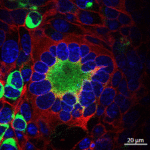Lien vers Pubmed [PMID] – 25210185
J. Virol. 2014 Nov;88(22):13429-35
UNLABELLED: Simian foamy viruses (SFV) are retroviruses that are widespread among nonhuman primates. SFV can be transmitted to humans, giving rise to a persistent infection. Only a few data are available concerning the distribution of SFV in human blood cells. Here we purified blood mononuclear cell subsets from 11 individuals infected with a Gorilla gorilla SFV strain and quantified SFV DNA levels by quantitative PCR. SFV DNA was detected in the majority of the CD8(+), CD4(+), and CD19(+) lymphocyte samples and rarely in CD14(+) monocyte and CD56(+) NK lymphocyte samples. The median (interquartile range [IQR]) SFV DNA counts were 16.0 (11.0 to 49.8), 11.3 (5.9 to 28.3), and 17.2 (2.0 to 25.2) copies/10(5) cells in CD8(+) T lymphocytes, CD4(+) T lymphocytes, and CD19(+) B lymphocytes, respectively. In the CD4 compartment, SFV DNA was detected in both memory and naive CD4(+) T lymphocytes. SFV DNA levels in CD4(+) T cells were positively correlated with the duration of the infection. Our study shows with a quantitative method that CD8(+), CD4(+), and B lymphocytes are major cellular targets of SFV in the blood of infected humans.
IMPORTANCE: Investigation of SFV infections in humans is important due to the origin of human immunodeficiency viruses (HIV) and human T cell lymphotropic viruses (HTLV) from cross-species transmission of their simian counterparts to humans. Surprisingly little is known about many aspects of the biology of SFV in infected humans, including quantitative data concerning the cellular targets of SFV in vivo. Here we show that the distribution of SFV DNA among the different leukocyte populations is not homogeneous and that viral load in CD4(+) T lymphocytes is correlated with the duration of infection. These new data will help in understanding the biology of retroviral infections in humans and can be useful in the growing field of SFV-based gene therapy.



